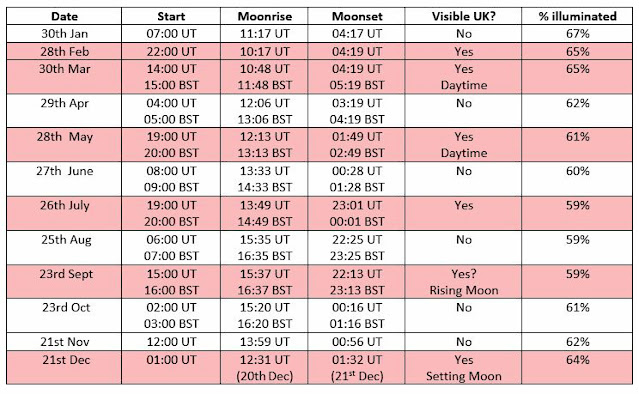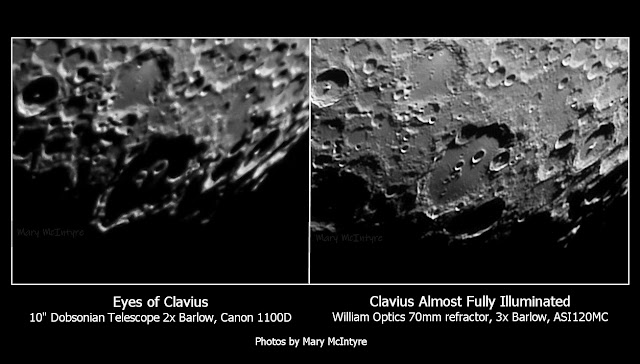Popular Clair Obscur Effects: Times for 2023
Lunar X & V, The Face in Albategnius and The Eyes of Clavius
by Mary McIntyre
Please note that the tables showing the timings below are photos because I have been unable to copy the text into a table in Blogger without the text getting scrambled. The downloadable PDF of this document is available and the tables there contain text that can be interpreted by E-reading software. You can download the PDF here.
Every year I produce a table showing the times that the Lunar X and V are visible for the coming year. I know these are the most popular of the Clair Obscur effects but they are not the only ones, so this year I am also including times for the Face in Albategnius and The Eyes of Clavius. Hopefully this will give you something new to try to tick off your lunar observing list. Detailed information about these effects is below, but for those of you who are only interested in the data tables, I’ve put those first. The moonrise/moonset times are for Oxford, UK, and will vary slightly across the UK. The times that the effects are visible are listed in UT so if you’re outside of the UK you can convert this to your own local time then and check the moonrise and set times for your area.
The Lunar X and V
The Face in Albategnius
Approximately 2 hours after the Lunar X is at its best, when the terminator has moved across to cover the area around it, take a close look at the shadows on the right hand side of the crater Albategnius (located almost halfway between the X and V). At just the right time the shadow looks like the side profile of a face. This shows up more clearly on stacked photos which have better resolution and sharper features. The above image was taken with a William Optics 70mm refractor with Celestron 3x Barlow. The camera was an ASI120MC.
The Eyes of Clavius
Additional information if you’re new to these effects:
The times given in the data tables are in 24 hour clock and are in UT/GMT (and BST where appropriate) so you will need to correct for time zones and daylight time savings if you are not in the UK. I have also included the approximate moonrise and moonset times in the tables. These times were taken from the Time and Date website and relate to my location in Oxford, UK. Your exact rise and set times will vary depending on where you are in the UK. You can check sunrise and set times for your location here:
To ascertain the times these effect appear each month, I used the NASA Scientific Visualisation Studio Moon Phase and Libration tool for 2023 (https://svs.gsfc.nasa.gov/5048)
Lunar X and V
The Lunar X and V are transient Clair Obscur effects which are visible on the lunar surface once a month for about four hours. The “X” is caused by light illuminating the rims of craters Blanchinus, La Caille and Purback. The “V” is caused by light illuminating crater Ukert along with several smaller craters. The X is at its most striking when it is visible on the shadow side of the terminator (as shown above). The X is located about a quarter of the way up from the bottom, just inside the shadow side of the terminator. The V is approximately half way up just inside the illuminated side of the terminator, and it really shines brightly against the darker background of Mare Vaporum. Once you know where to look, you will be able to spot them with large binoculars (it will help if they are mounted) but they are best viewed through a telescope. They will show up on photos taken with a 300mm zoom lens or through a modest telescope.
They will remain visible against the lunar surface for a few hours even after the terminator has moved over them. (see photo below).
Left: The lunar X and V seen at their best.
Upper right: The X and V can still be seen for a short time when the Sun has risen over those craters, but it isn’t as striking as when the X is illuminated against the unlit surface
The X and V are visible close to the First Quarter phase, however, due to libration, the exact time that they are visible is different from month to month. The lunar phase illumination at the time they’re seen during 2023 varies between 43% and 54%. The time that they occur may not coincide with the Moon being above the horizon from your location, so you will not see them every month.
From the UK, the Lunar X is visible seven times during 2023, but three of those apparitions are during daylight hours which are much harder to view, one is during twilight and one is when the Moon is close to setting. February and July are by far our best opportunities.
In previous years when I’ve observed the Lunar X using the start times from this tool, I have found it may take about 45 minutes from the start time before the X becomes clearly visible. The V tends to become visible a little earlier than the X. The start times are approximate, and they should be visible for a few hours after this. There is no fixed end-time listed because as mentioned above, these features remain visible even after the terminator moves across them, but if you assume they are visible for around four hours from the start time, you will see them at their best.
It’s really great fun to observe how the Lunar X and V regions evolve over time, so if you do make the effort to see them when they first appear, make sure you check that region again periodically to see how things have changed. The sketches below show how different the Lunar X region can look once the terminator has passed over it.
Pastel sketches by Mary McIntyre showing how the Lunar X stands out against better against the darker background before the lunar terminator has passed over it.
The Eyes of Clavius
Clavius is the second largest crater on the lunar nearside so it’s a brilliant crater to observe, even with modest equipment. It is a roughly circular crater that has a diameter of 225km, but its location near the southern limb means it appears foreshortened top to bottom so it therefore looks like it’s an oval shape when viewed from Earth. Interestingly, there are very few truly oval shaped craters on the Moon; almost all oval craters only look that shape to us because they’re foreshortened by their position near to the limb.
Comparison of Clavius as seen from Earth and from orbit. Clavius appears oval from
Earth due to foreshortening
Earth due to foreshortening
Clavius has several satellite craters along its floor. Clavius C and D, with diameters 21km and 28km respectively, have walls that are higher than the crater floor. As the Sun rises over Clavius, the tops of these crater walls catch the sunlight before the rest of the crater floor and this creates two white rings that resemble a pair of eyes looking out from the shadowy crater floor.
The Eyes of Clavius are visible during a Waxing Gibbous Moon, but as with other Clair Obscur effects, the exact phase angle varies each month due to libration. During 2023 they occur when the Moon is between 59% and 67% illuminated.
Left side: The Eyes of Clavius shine out from the shadowy crater floor as the Sun rises over Clavius.
Right side: Clavius fully illuminated with more satellite craters visible
If you enjoy observing the X and V, there many other Clair Obscur effects that are well worth seeking out. There is comprehensive list of them on Wikipedia here.
I really hope you found this post helpful. Please feel free to share this or the printable PDF with anybody who may find it useful.
Clear skies!
Mary McIntyre FRAS
Astronomy Communicator
Website: www.marymcintyreastronomy.co.uk
Twitter: @spicey_spiney
Instagram: spiceyspiney
Flickr: spicey_spiney
Mastodon: MaryMcIntyreAstro@astrodon.social









No comments:
Post a Comment
Note: only a member of this blog may post a comment.